|
| | Cuchillo a partir de circular de carpintero |  |
| | | Autor | Mensaje |
|---|
AurelioApe
Moderador

Mensajes : 2258
Fecha de inscripción : 01/07/2011
Localización : El Mierditerráneo
 |  Tema: Cuchillo a partir de circular de carpintero Tema: Cuchillo a partir de circular de carpintero  Lun 16 Oct 2017, 09:05 Lun 16 Oct 2017, 09:05 | |
| Con una sierra circular de carpintero, agotada en sus afilados, he fabricado este cuchillo. Siendo un ignorante en estos temas me ha parecido mejor acero que el de las radiales de obra que hasta ahora había usado, este es mucho más duro. Ya sé que una buena hoja requiere dureza combinada con flexibilidad y tenacidad, en realidad no sé si este material posee las cualidades aptas para un buen cuchillo. El uso lo dirá, de momento el cuchillo está hecho. El grosor de la hoja es de 3mm y el mango es una combinación de boj (la clara) y una madera que me encontré en la basura y desconozco; era parte de un mueble, si alguno la reconoce que me lo diga. Varias capas de aceite de linaza y una final conuna mezcla de este mismo y cera como acabado. Bruñido con un pedazo de hueso. La funda, reciclaje de chupa de cuero, con una vaina de madera interior para alojar la hoja. Imágenes de KK, tomadas con móvil de kk, lo siento  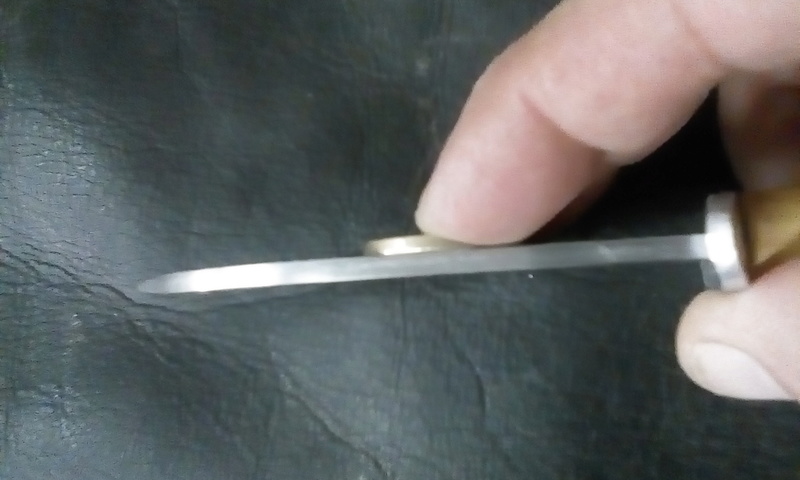 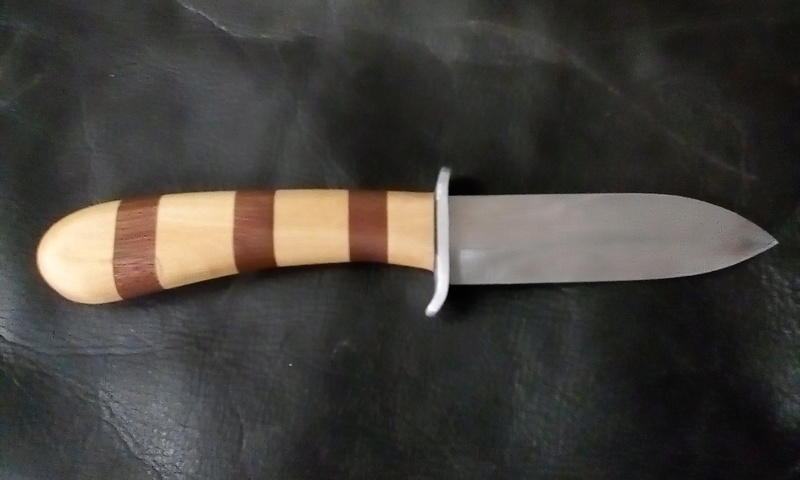 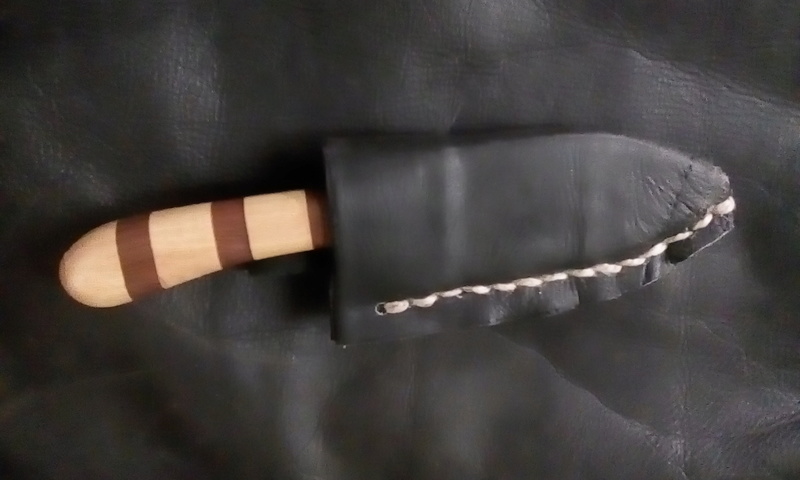   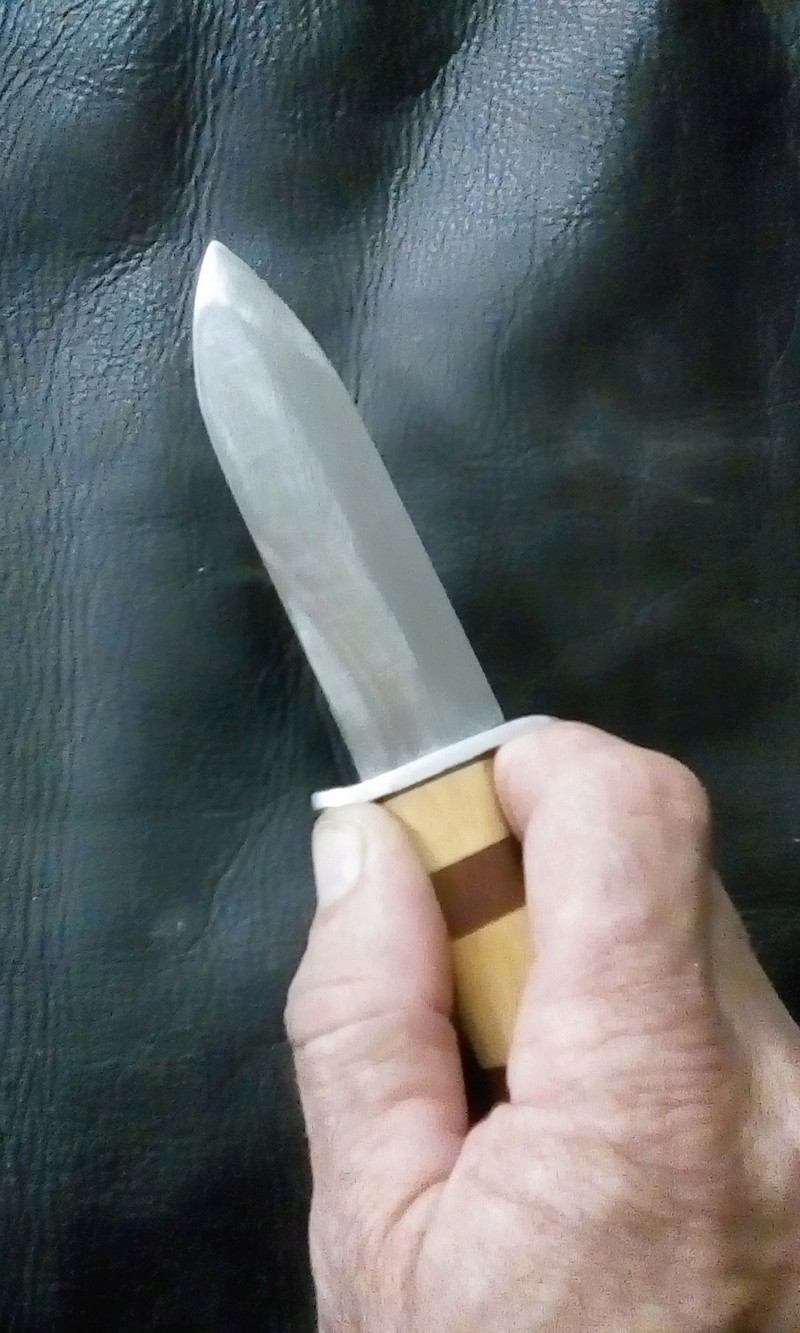 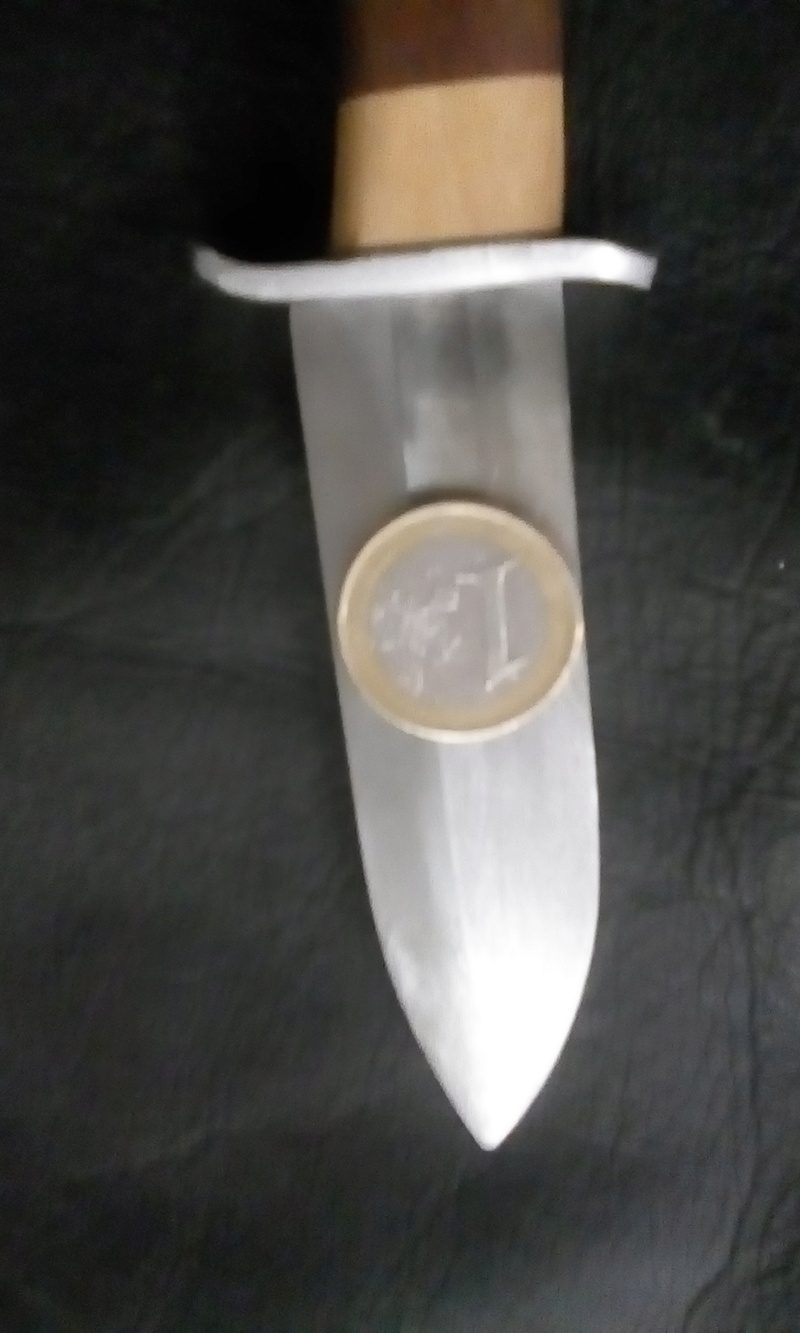
_________________
...entonces, el simio se puso en pié y cogió una roca...
|
|   | | Tino
Australopithecus
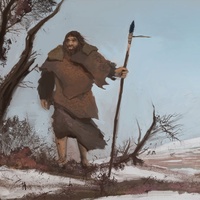
Mensajes : 40
Fecha de inscripción : 25/09/2017
Edad : 30
Localización : Macís del Caroig
 |  Tema: Re: Cuchillo a partir de circular de carpintero Tema: Re: Cuchillo a partir de circular de carpintero  Lun 16 Oct 2017, 09:16 Lun 16 Oct 2017, 09:16 | |
| No tengo ni idea de fabricación de cuchillos, pero el mango tiene una pinta impresionante con la combinación de ambas maderas, y su forma me gusta bastante eso de que acabe "engrosandose". La hoja parece robusta, esperemos que aguante mil batallas!   Por cierto, ¿que tipo de espiga tiene la hoja? |
|   | | AurelioApe
Moderador

Mensajes : 2258
Fecha de inscripción : 01/07/2011
Localización : El Mierditerráneo
 |  Tema: Re: Cuchillo a partir de circular de carpintero Tema: Re: Cuchillo a partir de circular de carpintero  Miér 18 Oct 2017, 11:01 Miér 18 Oct 2017, 11:01 | |
| Gracias Tino, por desgracia le hice la espiga a 90º de la hoja; a posteriori vi un post del Maisu que aclaraba la cuestión   . Para el próximo... 
_________________
...entonces, el simio se puso en pié y cogió una roca...
|
|   | | dunkleo
Moderador

Mensajes : 5261
Fecha de inscripción : 26/05/2012
Edad : 58
 |  Tema: Re: Cuchillo a partir de circular de carpintero Tema: Re: Cuchillo a partir de circular de carpintero  Miér 18 Oct 2017, 11:15 Miér 18 Oct 2017, 11:15 | |
| Que facilidad tienes para hacer cualquier cosa relacionada con este foro. Eres un crack AurelioApe. Un abrazo y recuerdos a la familia.   |
|   | | iurde
Homo sapiens sapiens

Mensajes : 7249
Fecha de inscripción : 17/11/2010
Edad : 65
Localización : Las verdes colinas de Cantabria
 |  Tema: Re: Cuchillo a partir de circular de carpintero Tema: Re: Cuchillo a partir de circular de carpintero  Miér 18 Oct 2017, 12:10 Miér 18 Oct 2017, 12:10 | |
| No te digo más, porque ya lo dices tú.  ¿Y esa guarda doble? ¿Es por estética, o porque no quieres que te resbale la mano hacia la hoja cuando se la claves entre las costillas al enemigo?  |
|   | | AurelioApe
Moderador

Mensajes : 2258
Fecha de inscripción : 01/07/2011
Localización : El Mierditerráneo
 |  Tema: Re: Cuchillo a partir de circular de carpintero Tema: Re: Cuchillo a partir de circular de carpintero  Jue 19 Oct 2017, 08:17 Jue 19 Oct 2017, 08:17 | |
| Gracias Marcel. Soy como un niño, me encanta jugar con mis juguetes (herramientas) y claro, como soy catalán: "hago cosasss"   Por estética Alfonso, solo por estética. Aunque nunca se sabe...   Por cierto supongo que la doble es la de arriba y la habitual la del filo ¿no?
_________________
...entonces, el simio se puso en pié y cogió una roca...
|
|   | | iurde
Homo sapiens sapiens

Mensajes : 7249
Fecha de inscripción : 17/11/2010
Edad : 65
Localización : Las verdes colinas de Cantabria
 |  Tema: Re: Cuchillo a partir de circular de carpintero Tema: Re: Cuchillo a partir de circular de carpintero  Jue 19 Oct 2017, 09:51 Jue 19 Oct 2017, 09:51 | |
| Se llama guarda doble porque asoma por ambos lados, arriba y abajo. Guarda simple es la que guarda el dedo del filo. Pero se emplea en puñales. Es decir, en cuchillos hechos más bien para pinchar. Yo no suelo poner guardas en mis cuchillos, porque están hechos para cortar; y se corta, normalmente, tirando y no empujando. Y porque la guarda me impide cortar sobre una tabla, por ejemplo, con la parte más cercana a la empuñadura. Suelo hacer una pequeña muesca para que el dedo note dónde acaba la empuñadura, pero ni siquiera que el dedo se encaje, sino que como mucho, se apoye. Los cuchillos nórdicos ni siquiera tienen esa muesca, y la gente los usa a diario y no se corta. Pero es cuestión de empuñar el cuchillo adecuadamente, y de cortar como es debido. Dicho todo esto, si es por estética, bien puesta está tu guarda.  |
|   | | Golem.
Australopithecus
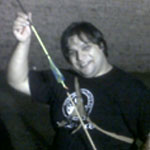
Mensajes : 82
Fecha de inscripción : 02/04/2015
Localización : Barcelona
 |  Tema: Re: Cuchillo a partir de circular de carpintero Tema: Re: Cuchillo a partir de circular de carpintero  Vie 20 Oct 2017, 00:07 Vie 20 Oct 2017, 00:07 | |
| Maisu, que lecturas me recomiendas sobre el diseño de cuchillos, me refiero, mas a la parte de las formas y ergonomias de la hoja y el mango que a la metalurgia del proceso.
He encontrado una hoja para encabar que compre hace años y no quiero cometer los mismos errores que con mi primer cuchillo. |
|   | | iurde
Homo sapiens sapiens

Mensajes : 7249
Fecha de inscripción : 17/11/2010
Edad : 65
Localización : Las verdes colinas de Cantabria
 |  Tema: Re: Cuchillo a partir de circular de carpintero Tema: Re: Cuchillo a partir de circular de carpintero  Vie 20 Oct 2017, 10:29 Vie 20 Oct 2017, 10:29 | |
| Mmm... No es fácil recomendar una sola lectura, porque la mayoría de autores trabajan por intuición, o tienen un modelo o líneas personales que repiten una y otra vez. Como yo, vamos. Con los años, he logrado definir y sistematizar algunos elementos de diseño, y puedo justificarlos, pero no dejan de ser cuestiones subjetivas. Otro artesano puede justificar sus opciones de otra manera. Todo depende del uso del cuchillo. Lo cierto es que hay poco publicado sobre ergonomía y diseño. Yo he ido leyendo artículos acá y allá a los largo de los años en revistas estadounidenses y francesas, pero no es gran cosa. Tendría que buscarte dónde y cuándo leí esto o aquello, y las revistas de cuchillería en mi casa ocupan casi dos metros de estantería en la biblioteca. Es casi mejor que me plantees tus dudas concretas, y si puedo, te doy mi opinión. Puedes abrir un hilo especçifico. O venirte al próximo curso de elaboración de cuchillos que imparta en Pontós (con permiso del boss, el gran pescado). Te adjunto unas notas que encontré en un foro de cuchillos nórdicos hace mil años (el foro ya ni existe) sobre las reflexiones que un cuchillero daba a los asistentes a un curso. Ya ves que no es nada concreto, sino reflexiones... Quizá te ayude. Si no, abre un hilo o ven a Pontós la próxima vez  ................................................................................... UnityThe words on the South African coat of arms used to read: "Ex Unitate Vires" - Unity through diversity - and a more mixed up country is difficult to find.The analogy to knifemaking is not difficult to see. Knifemakers use a bewildering variety of techniques and materials. Nowhere else will one see titanium, nickel, iron, cobalt, carbon, a dead animal's tooth, a mixture of chemicals called epoxy and a touch of gold combined to create an object of beauty.Combining these elements in a crucible will not yield a knife, only a very interesting piece of slag. If one follows the directions set down by generations of craftsmen you will be able to combine all these elements to form a knife.The same with the elements of design. Viewing them as separate entities does not reveal the fact that when combined in the right manner they can be unit; they will look like they belong together.If the shape of the handle reflects something of the curve of the blade, there is unity. Subtler is the source of the handle materials reflected in the shape, texture or purpose of the knife. InspirationWhereas the design of a knife is a mental exercise done with pencil and paper, the spark that sets the whole process in motion comes from the environment. One can say that inspiration is external and design internal. A good designer is always exploring his environment for inspirational material. The search can be as rewarding as the discovery as one learns about history, natural history, ecology, geology, mechanics, and sociology, a bit of everything under the sun.A museum is a good place to start one's explorations, as one can see old tools and weapons and learn more about the people who used or made it. One can also see a wide range of objects from antiquity to modern times, all of which were designed for some purpose and according to certain aesthetic criteria. Seeing how a Stone Age wife decorated her clay pots might give you an idea for the texture or shape of the next knife.This is just one example of the countless possibilities awaiting any designer who has learned to look at everything around him with a mind that is ready to grasp at the slightest indication that the object he is looking at can lead to an improvement or some new feature in his work.There are two passages every designer should put on his wall: "The eyes are the windows of the soul" What you look at, read, touch and see each day not only influences your life, but your designs as well. Inspiration from natureVery few natural shapes resemble knives: blades of grass, teeth and some leaves.The richness of natural inspiration does not only lie in the shape of the resultant knife, but in all of the design elements. If you are looking for complete knives in natural objects you will soon be discouraged, you need to look more carefully and consider all the elements of design as well as all the parts that make up a knife.Look past the whole, study each individual feature of the object and discover a new world of design. Sometimes you need to turn an object upside down. Sometimes one needs to delve deeper, past the skin and muscles to the very bone to find truly inspiring shapes.An afternoon spend behind a microscope will reveal a huge source of shapes and patterns. The wing of a fly, the business end of a wasp and a bee's knee will show that the closer you look the better it gets.A walk in the park or a local woodland will reveal more patterns and textures than you can use in a lifetime. By taking along some thin, strong paper and a few wax crayons you will be able to make rubbings of all the interesting textures, surface and patterns found on rocks, tree trunks, dead wood, leaves, etc.Most knifemakers use a random pattern when texturing blades, or jigging bone. By going through a selection of rubbings one is bound to find a pattern that will fit the knife to the hilt.Scrimshaw and engraving is often done to reveal the whole or part of a picture. How about asking your favorite scrimshander to zoom in by a factor of ten, twenty or even a hundred? Why make a miniature leopard on a life size knife? Place the handle on a leopard skin and duplicate the pattern that is covered on a one to one scale. The glistening scales of a rainbow trout or the magnified wing of a butterfly will make for magnificent scrimshaw. Inspiration from man made objectsAs was stated at the beginning of this chapter, a museum is a good place to start one's explorations into the world of design. One of the first things one notices is that very few things are made with purpose as sole criteria. Mankind has a built in need to make the objects he uses pleasing to the eye and comfortable in use. It also becomes clear that design is subjective; beauty is in the eye of the beholder.As designer, you need to please yourself, if the work you are doing is not to your taste it is not worth doing. As a businessman doing design and making for an income, then your work must be pleasing to your customers, else it is also not worth doing. You need a place to stand between these two extremes, where you will be able to do the work you like and make a living at it, or if you are pursuing a hobby, cover the cost of tooling and materials.By studying objects made for mass consumption one can easily fall into the trap of mediocrity, where you will be competing with the factories whose market is the average buyer. ....to be continuedPero nunca continuó.  |
|   | | iurde
Homo sapiens sapiens

Mensajes : 7249
Fecha de inscripción : 17/11/2010
Edad : 65
Localización : Las verdes colinas de Cantabria
 |  Tema: Re: Cuchillo a partir de circular de carpintero Tema: Re: Cuchillo a partir de circular de carpintero  Vie 20 Oct 2017, 10:42 Vie 20 Oct 2017, 10:42 | |
| Otro artículo que tengo guardado por aquí:As an addition to Birgers excellent summary of our experience with Knut Dahl on the subject: "Uncle Knut sketches and explains..", I have tried to make notes on some of the more practical examples Knut mentioned during our talk.The starting point for our discussion was some of the more formal rules and relations that has been used through the ages on the subject good design/good proportions. The easiest to understand and apply, and probably also the best known, is the golden section, which has a relation between the dimensions of 5 to 8. This relation is said to be found everywhere in nature, including the human body, and therefore most people will find the golden section very harmonic. Those points in a picture, that lies in the cross points of the golden section, will always draw special attention.When we are talking about knives, one can use the ratios of the golden section to dimension the blade and the handle. In Scandinavian knives a blade of 7-8 cm is very common, and this will fit very well with a handle of 11-12 cm length. Furthermore one can use the ratio in the sheath, as the part covering the blade and the part covering the handle are approx. of the same length, and this will leave approx. 3/8 of the handle uncovered.This naturally doesn’t mean you can’t make knives with other dimensions, but if you choose this starting point you will have a natural harmony, and this will make it easier to make a harmonic knife.Another point that has great influence on your perception of lines and proportions, is balance. In a knife, the 2 parts on each side of the longitudinal axis must be in balance when you watch the knife in profile, and there must be a visual balance around the optical "centre of gravity" of the knife. Viewed from the edge or the spine, most knife makers will choose a symmetrical design, but if you choose an asymmetrical design, once again balance is an important subject.Spirals are very powerful design elements, and they will often steal the scene ! As an exercise drawing spirals is a good idea, because when you are able to easily draw a harmonic spiral, you will have a good starting point to get strong control over your design work in general.As Birger already pointed out in his summary, one will often find that "peace calls for unrest", and the other way round. This can mean that one will choose a powerful sheath for a more discrete knife, while a powerful knife will be better suited for a discrete sheath. Also when it comes to the decoration of the knife itself or the sheath itself, one can work with the "peace-unrest" parameter, and in this way create a more interesting overall design. When you make a drawing of a knife, Knut strongly recommend to avoid big differences in the circumference of the knife, and especially one should avoid abrupt changes. Obeying this rule will make it easier to create harmonic knives. Knut Dahl always draws his knives independent of the sheath, this means he will design the knife first, and once this is done he will design a sheath that together with the knife will form a nice overall design. Often it will be a good idea to think of possible sheath designs during the design of the knife, and a certain design of the knife will definitely limit the possibilities in the sheath design.Knut strongly suggest you try to work intuitively - don’t use your head to much ! It can be very difficult to "set yourself free", but it is a good way to work, if you want to come up with radically new designs, and it makes it possible to become complete independent of what you have done so far. As a general rule one can say that immersion and concentration pays of in the end !!!!The problem of introducing a suitable finger guard on the knife without sacrificing the overall "lines", could be solved by introducing a thickening of the handle close to the blade (on the sides of the handle). This will leave a little edge, that can easily be found when you use the knife. Alternatively one could have a number of small grooves in the handle, and this will basically have the same effect. These element are a lot easier to integrate in the design, but of course they will not give your fingers the same amount of protection against sliding down on the edge during use.These were some of the more practical examples of Knut Dahl’s design philosophy, but as it easily can be seen, there are no easy-to-apply rules of thump. The ability to see different shapes and lines is possible to train, and has to be trained during practical use. When you several times have "seen the light", eventually different elements will be a natural part of your design process. Often very diminutive details and changes will lift a knife from the group of good and ordinary knives to the extraordinary and remarkable masterpieces........................................................
Knut Dahl, el cuchillero del que se habla en el artículo, es un reputado artesano danés. |
|   | | iurde
Homo sapiens sapiens

Mensajes : 7249
Fecha de inscripción : 17/11/2010
Edad : 65
Localización : Las verdes colinas de Cantabria
 |  Tema: Re: Cuchillo a partir de circular de carpintero Tema: Re: Cuchillo a partir de circular de carpintero  Vie 20 Oct 2017, 10:46 Vie 20 Oct 2017, 10:46 | |
| Y otro más:On design and lines. written by Birger Dahl JepsenThis was the group’s subject for Friday evening at Holstebrogruppens latest course at Langvad. The instructor was Knut Dahl from Norway. A knife maker, who in my opinion, is at his best when it comes to design and lines. We all had quite high expectations to this part of the agenda. And we had some very exciting hours together with Knut Dahl. I have accepted the task of trying to give a resume of these hours. I think it is difficult to do, and if I ramble too much, please blame it on me. Not Knut - he didn’t ramble, but made us all "see the light" several times. My first note says: design is a matter of awareness. Awareness of what it is, that suddenly catches the eye and make you say "yes - now it’s right". Or make your hand or fingers feel, that now it feels the way it’s supposed to feel. In Knut’s consciousness this is a lifelong process, that will never end. During your work, you will all the time become aware of new details, that will change your opinion on what good design and good lines really are. Throughout our talk, Knut constantly distinguished between the whole and the details. Amongst other things, he said that details like fitting the blade to the handle, or making the front part fit perfectly to the wood, is all a matter of technique. To design a knife could be compared to drawing a portrait, in which proportions are extremely important. Drawing is communication with a higher/deeper layer inside yourself. This comment I would like to elaborate a bit, but I don’t really know how ? Harmony is an expression of security - or need for security. In our group we have often discussed how you can develop your own style. Or if any of us can be said to have his own style ? Knut gave the following contribution to this: When you are working on a knife, cutting, sanding or pauting, you tend to focus 100% on the "work", and during this you will make a lot of choices, both conscious and unconscious, and this will put your intellect in the background. When such things happen, the knife maker creates his or her own style. At this point, Knut mentioned that many people through the ages have tried to decide or make rules for good or pleasant design. One example, that most people know more or less, is the golden section. On the flip over Knut showed us some examples of how theses rules have been applied within different disciplines. His background as a graphic artist showed very clearly. From here he moved on to the concept of "peace versus unrest". His claim is that the one calls for the other, as we all have a sense of balance to some extent. In all aspects of life we seek balance and harmony, but from time to time we challenge balance and harmony in order to create tension or excitement in life. We all have a creative inner-self. Immerse yourself, spend a lot of time and concentrate - often you’ll find the answer to your problem as a result of your effort. But all from an unconscious origin. This was the last of my notes. I feel there are some very strong statements among them - and some very good observations. This goes for design and lines - but indeed also for a lot of other aspects of the life we lead. During his presentation Knut asked us to take one of our knives out of it’s sheath. Sketch the outline of the knife, and around this draw a new sheath for the knife. Then he walked around and took a look at our work, commented it and gave us all some good advice. During this Knut’s big talent in this field really showed very clearly. And every one of us had some really good hints to guide us in our further efforts. In my sketch Knut wrote one word in very big letters............... CORRELATION............
This really gave me something to think about.Of course Knut had some supporting comments for me. And I must admit he is right !Look carefully, you fool ! ......................................................................................................... Si alguien se interesa por el diseño de cuchillos, estos artículos pueden dar mucho juego. En serio. |
|   | | iurde
Homo sapiens sapiens

Mensajes : 7249
Fecha de inscripción : 17/11/2010
Edad : 65
Localización : Las verdes colinas de Cantabria
 |  Tema: Re: Cuchillo a partir de circular de carpintero Tema: Re: Cuchillo a partir de circular de carpintero  Vie 20 Oct 2017, 11:11 Vie 20 Oct 2017, 11:11 | |
| |
|   | | alcion
Homo sapiens sapiens

Mensajes : 3582
Fecha de inscripción : 10/10/2011
Edad : 56
Localización : Utrera
 |  Tema: Re: Cuchillo a partir de circular de carpintero Tema: Re: Cuchillo a partir de circular de carpintero  Miér 25 Oct 2017, 13:14 Miér 25 Oct 2017, 13:14 | |
| |
|   | | AurelioApe
Moderador

Mensajes : 2258
Fecha de inscripción : 01/07/2011
Localización : El Mierditerráneo
 |  Tema: Re: Cuchillo a partir de circular de carpintero Tema: Re: Cuchillo a partir de circular de carpintero  Lun 30 Oct 2017, 11:36 Lun 30 Oct 2017, 11:36 | |
| La madera oscura de la empuñadura tiene muchos números de ser Sapelly; aunque al carpintero que me lo ha dicho, también le encajaba el Cedro. Si alguien me confirma una de las dos, ya lo diré.
_________________
...entonces, el simio se puso en pié y cogió una roca...
|
|   | | iurde
Homo sapiens sapiens

Mensajes : 7249
Fecha de inscripción : 17/11/2010
Edad : 65
Localización : Las verdes colinas de Cantabria
 |  Tema: Re: Cuchillo a partir de circular de carpintero Tema: Re: Cuchillo a partir de circular de carpintero  Miér 01 Nov 2017, 00:33 Miér 01 Nov 2017, 00:33 | |
| Pon foto de detalle, y quizá lo veamos más claro.  |
|   | | | | Cuchillo a partir de circular de carpintero |  |
|
Temas similares |  |
|
| | Permisos de este foro: | No puedes responder a temas en este foro.
| |
| |
| |

